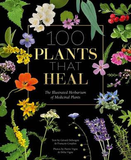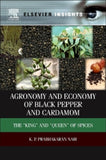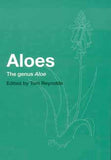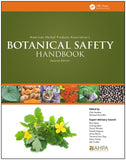The Modern Ayurveda: Milestones Beyond the Classical Age by C. P. Khare, Chandra Kant Katiyar
The Modern Ayurveda: Milestones Beyond the Classical Age
Features
- Covers the transition period of Ayurvedic medicine from the classical to the modern age
- Provides a comprehensive source for scientific aspects of modern Ayurveda
- Includes the new classification of Ayurvedic herbs, bioactive constituents, photochemical markers, and herb interactions
- Discusses the application of modern scientific analytical tools for standardization, modern pharmacological tools for safety and efficacy evaluation, and the application of biotechnology to elicit the mechanism of drug actions
- Presents the global regulatory status of Ayurvedic herbs
Summary
The Indian population has used Ayurvedic herbs for centuries, but now modern scientific work has led to recognition and acceptance at a global level. The major cause of the increased popularity of Ayurvedic medicine stems from recent scientific validation and its potential in lifestyle management. This growth in research in India and worldwide has created the need for a resource covering the scientific development of Ayurvedic herbs for practice during the postclassical period. The Modern Ayurveda: Milestones Beyond the Classical Ageexplores a host of topics essential to understanding the surge of scientific work now being conducted on this ancient practice.
A one-point source for the modern explorer attempting to appreciate the transformation of Ayurveda from an empirical to a rationalist understanding, the book enumerates more than 400 Ayurvedic herbs with compiled information including their botanical name, common Ayurvedic name and family, their attributes, chemical constituents, phytochemical markers, pharmacological actions, and their interactions and toxicity. It explores current research methodologies for the evaluation of efficacy and safety of herbal medicine and discusses the contemporary international regulatory status of herbal drugs.
Ayurvedic medicine can be better understood and utilized through the application of modern scientific analytical tools for standardization, modern pharmacological tools for safety and efficacy evaluation, and the application of biotechnology to elicit the mechanism of drug actions. Bringing Ayurveda into the 21st century, this volume will inform further progress and open new doors to treatment.
Table of Contents
How the Concept of Modern Ayurveda Emerged; C. P. Khare
Transition from Ancient to Modern Ayurveda; Chandra Kant Katiyar
Ayurveda and Traditional Chinese Medicine: Challenges and Strategies; Chandra Kant Katiyar
Introduction
History and Philosophy
Basic Principles
Current Status
Scope and Achievements
Issues and Perspectives
Conclusion
References
Herb Nomenclature of the Last Classical Ayurvedic Treatise: Bhavaprakasa
By Botanical Name
By Ayurvedic Name
Classical Attributes of Ayurvedic Herbs
Bioactive Constituents of Medicinal Plants; V. K. Agarwal
Alkaloids
Classification of Alkaloids
General Properties of Alkaloids
Pharmacology
Anthocyanins
Flavones
Flavonoids
Tannins
Properties of Tannins
Industrial Uses of Tannins
Essential Oils
Pharmacology
Menthol
Camphor
Clove
Cypress
Lavender
Jasmine
Patchouli
Eucalyptus
Rosemary
Other Uses of Essential Oils
Terpenoids
Steroids
Sterols
Cholesterol
Ergosterol
Stigmasterol
Cardioactive Glycosides
Steroidal Glycosides
Cardiac Glycosides of Digitalis
Saponins
Saponins from Licorice
Saponins from Soapnut
Pharmacological Activity of Saponins
Gum, Resin, and Mucilage
Gums and Mucilage
Resins
Bitters
Pungent Constituents
Coumarins
Anthraquinones
Chemical Constituents of Ayurvedic Herbs
Phytochemical Markers of Ayurvedic Herbs
Interaction, Toxicity, and Specific Findings from Ayurvedic Herbs; C. P. Khare
Modern Pharmacological Classification of Ayurvedic Herbs; Chandra Kant Katiyar and Arun Gupta
Antacids
Antiallergics
Antiasthmatics
Anticancer
Antidiabetics
Antidiarrheals
Anti-DUB
Antiemetics
Antiflatulents
Antihypertensives
Anti-Inflammatory
Antimicrobials
Antiobesity
Antiparkinsonians
Antipyretics
Antispasmodics
Antistress
Antitussives and Expectorants
Antiurolithiatics
Aphrodisiacs
Blood Purifiers
Cardioprotectives
Digestives
Diuretics
Galactogogues
Hepatoprotectives
Hypolipidemics
Immunomodulators
Laxatives
Narcotics
Nephroprotectives
Nootropics
Sedatives
Skin Disorders
Tonics
Wound Healers
Evaluation of Efficacy and Safety of Herbal/Ayurvedic Medicines; Arun Gupta and Chandra Kant Katiyar
Introduction
Definitions
Historical Aspects
Regulatory Aspects on Conducting Clinical Trials
World Health Organization (WHO) Guidelines
Indian Council of Medical Research (ICMR) Guidelines
Good Clinical Practice (GCP) Guidelines
Department of AYUSH, India
Ethical Issues
Limitations of Herbal and Traditional Medicine with Reference to Clinical
Trials
Trial Design
Randomized Controlled Trials
Blinding
Placebo
Standardization or Quality Control
Ayurvedic Perspective
Need of Alternative Approach to Clinical Trial for Traditional Medicine
Prakriti (Psychosomatic Constitution)
Rogi (Patient), Roga (Disease), and Pariksha (Examination)
Kriyakala (Interventions at Different Stages of Disease)
Pathya-apathya (Diet) to Be Followed with Medicine
Anupana (Vehicle) for Drug Administration
Proposed Methodologies for Clinical Trials on Ayurvedic Drugs
Toxicity Studies on Ayurvedic and Herbal Drugs
Acute Toxicity (OECD Test No. 43)
Subacute Toxicity (OECD Test No. 412)
Subchronic Toxicity (OECD Test No. 413)
Chronic Toxicity (OECD Test Guideline 452)
Carcinogenicity (OECD Test Guideline 451)
Test Guideline 416)
Ocular Toxicity (OECD Test No. 4052)
Neurotoxicity (OECD Test No. 424)
Conclusion and Way Forward
References
International Regulatory Status of Herbal Drugs; Sanjay Sharma
Southeast Asia
Bangladesh
India
Indonesia
Myanmar
Nepal
Sri Lanka
Thailand
Eastern Mediterranean
Egypt
Iran
Kuwait
Pakistan
Saudi Arabia
United Arab Emirates
Western Pacific
Australia
China
Fiji
Japan
Africa
South Africa
The Americas
United States of America
Argentina
Canada
Chile
Nicaragua
Europe
European Union
Conclusion
Bibliography
Information Resources
Databases
Herbal Monographs
Publicly Available
Subscription Based
Online Journals, Libraries, and Citations
Professional Associations
Related Links
Images
Adverse Effects, Safety, and Standards
Legal and Regulatory Information
Country-Specific Complementary and Alternative Medicine
United Kingdom
United States of America
India
Index
Related Products
-
100 Plants That Heal: The Illust...
1,700.00
2,000.00 -
A Textbook of Modern Toxicology,...
8,942.00
10,520.00 -
Agronomy and Economy of Black Pe...
2,495.00
10,995.00 -
Aloes: The Genus Aloe edited by ...
2,446.00
2,795.00 -
American Herbal Products Associa...
8,400.00
9,500.00 -
Aromatic and Essential Oil Plants
1,450.00
- Architecture & Construction Management Books
- Biochemistry, Bioengineering and Biotechnology Books
- Books on Analytical Techniques, GC MS, LC, TLC, HPLC, NMR Spectroscopy
- Books on Water and Wastewater Treatment, Analysis Water Treatment Plants
- Chemical Technology, Organic Chemistry, Chemical Synthesis and Chemical Analysis Books
- Cosmetics Science, Cosmetics Formulations, Manufacture and their Analysis Books
- Drugs and Pharma Science Books
- Essential Oils, their Analysis, Natural Products Extraction, Distillation , Isolates Related Books
- Flavor Science, Flavor Analysis, Flavor Creation, Food Flavors Books
- Food Science and Technology, Baking , Food Ingredients , Food Quality , Food Regulations
- Formulations of Perfumes for Agarbatti, Air Freshners, Soaps & Detergents, Fabric Softeners , French style Perfumes, Attars , OUD, Fine Fragrances
- Fragrances, Scents, Attars , Perfumery and Aroma Chemicals Books
- Herbal, Ayurvedic, Medicinal Plants and Aromatic Plants Books
- Law Books
- Major Reference Works (MRWS) Sets - MultiVolume Sets
- Medical Books
- Medical Journals Wolters Kluwer | Medknow India
- NEW ARRIVALS
- Perfumer's Resources
- Special Indian Reprint !


















